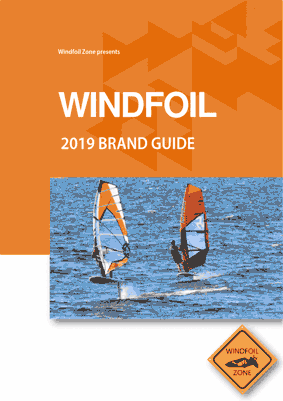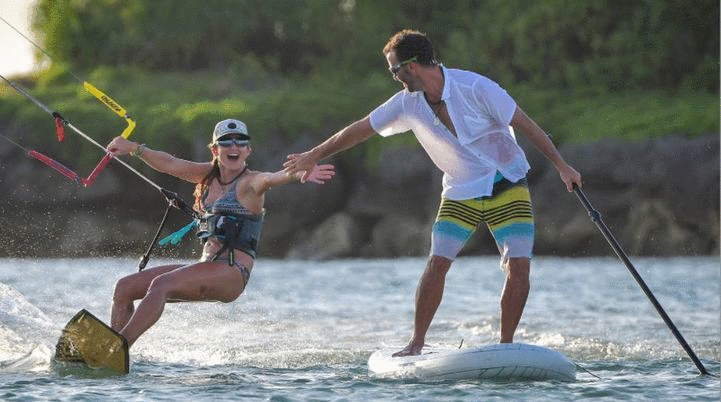5 Board Nose Protections For Your Next Windsurf Foiling Session!
- Romain
- Jun 14, 2020
- 7 min read
Updated: Dec 30, 2020
All windsurfers using a harness have experienced catapult crashes:
Losing your balance and being dragged by the sail towards the front of your board. The crash can be everything from smooth to violent. Worst case, it’s an expensive error, as board or sails often get damaged.
This is, of course, a beginner error but it still happens from time to time to more experienced windsurfers as well. However, It’s actually quite seldom to see people using board guards or mast guards. I don’t know exactly why? Maybe people feel stupid or want to show that,“I don’t need any protection, this won’t happen to me…”.

Fred Hope of Slingshot falling hard
The funny thing with windfoiling is that you actually start learning from scratch again: You need to find the right body position to balance on the foil and control the height with the right pressure on your feet. Those who used to be good windsurfers are now back to the school bench, and make beginners mistakes all over again.
The most common mistake when learning how to windfoil is to “over-foil”: The foil gets too high and breaks the water’s surface, following an immediate loss of control as the nose of the board dives into the water. It often results in a catapult with physical consequences, breaking the nose of your board.
For these reasons, we highly recommend to learn foiling with adequate protection to avoid any unfortunate adventures, breaking your brand new €2000 carbon foiling board after the first foiling session…
I have tested and seen different options out there to protect your board from involuntary catapults, and I wanted to share with you my findings and highlights. Here are 5 different options, from cheap and easy to more advanced.
The Surfbent is a new accessory for windsurfing. You may be familiar with the Deviator in the early 2000’s, which used the same idea: deflecting your rig away from the nose.

The Deviator was a good idea, but the product had a very clumsy design. It made waterstarting harder because you needed to clear the sail over the Deviator and it got in the way of your feet when tacking.
The Deviator was a good idea, but the product had a very clumsy design. It made waterstarting harder because you needed to clear the sail over the Deviator and it got in the way of your feet when tacking.
The Surfbent is in many ways an improved version of the Deviator:
It is lighter and located in the center of gravity of the surfboard.
The complete trim area of the mast rail can be used because the Surfbent wbp is mounted instead of the friction plate of the mast foot.
The ring shape not only protects the tip of the board, but also the lateral area of the board. In addition, the Surfbent wbp is narrower around the mast.
Also the handling during surfing is better, because you can stand with your feet closer to the rig and therefore there are hardly any problems while surfing.
In contrast to the Deviator, the neat and slim design makes the handling of the rig in the water much easier.
I was curious to try the Surfbent, and ordered one to see how it performs and share my thoughts with you. I have been testing the Surfbent for a while now, and here are my comments:
Even if the Surfbent apparently looks like a piece of hard plastic, it is actually made of an “elastomer” material, which is a polymer with viscoelasticity. Such materials can be deformed when a load is applied, and then comes back to its original form. So, when you fall forward, the rig hits the Surfbent protector first, and the resulting energy is dissipated by the deformation of the Surfbent. Your nose is safe, and the contact and shock between the mast and the Surfbent is absorbed by the material, preserving your mast and mast track from breaking as well.
Here is a small video showing how the Surfbent stops the mast from crashing your board, and a crash session in overpowered 7.0m conditions !
The Surfbent has a neat and slim design, and comes in different colours to match your own equipment, which makes it discrete on your board. The round and low shape takes very little place on the deck, and doesn’t hamper manoeuvers, when either tacking or freestyling. Its weight (340g) is not an issue either as it’s very light and placed at the center of gravity of the board (under the mast).
Unlike the Deviator, I feel that the Surfbent is actually making waterstarting easier, as the shape of the protector gives an up-lifting effect (lifting the sail out of the water towards the start position).

Surfbent in action
Andreas Boos, the creator of the Surfbent, claims that, “the product has been tested with crashes in all conditions and on different boards during 3 years before being released on the market, and it has held all impacts. At the moment, there are also several hundred Surfbents continuously in use in different surf schools, and so far I have only received positive feedback”.
An extra comment from the producer though: The Surfbent is a good security, but not a guarranty that you will not damage your board. In case of very hard fall, there is still a possibilty that the mast hits the nose of the board. But at least the shock will be obviously smaller than without the Surfbent. It is also recommended to use a tendon mast foot (which is somehow stiffer than a boge mast foot) and replace the tendon once a year to keep maximum stiffness.
Conclusion:
After having tested it for a while, I can attest that it’s a great accessory, which actually will save you from board repairs without any major drawbacks. The Surfbent has now become fixed inventory in my standard windfoiling equipment, and we have decided to distribute it in our online store.
If you want to order a Surfbent WBP, you can do it directly in our online store.
PROS:
Easy to set-up
Good shock absorption
Limited influence on the riding
Nice design and multiple colors to choose from
The new 2020 version is wider and allows mastfoot up to 12.2cm to be used, and is also compatible with 2-pin mastfoot
CONS:
The Surfbent do not fit boards with a concave / recessed deck, like the IQ Foil and some Starboard formula boards for example. (A new IQ Foil surfbent is under development)
The Surfbent can create extra stress on the mastfoot. Check out your mastfoot regularly, and change your tendon once a year.
It's not a 100% warranty against damages, but a good extra security.
2. The “ready-to-apply” nose guard from Unifiber
Unifiber is proposing an EVA nose guard with 3M tape. Same principle as the pool noodle (see point 4. the DIY Nose guard), but there are two hard layers of EVA to disperse the impacts and a softer layer beneath absorbs them. I have been using this nose guard for a while and I’m very happy with it.

I would recommend ordering the XL version, as most of the windfoil boards have a pretty large nose and the XL nose guard will fit best. (I originally chose the L version, and it was a bit too narrow).
Remember to hold the protection and the board together for at least 24 hours to be sure the glue gets hard enough.
Here is a small video showing you how to apply the protection on the nose of your board:
If you find the Unifiber to be the right option for you, click here to order it from our online store .
PROS:
Good shock absorption
Easy to apply with 3M adhesive bonding
Light weight and good aerodynamic. This is critical to performance and sailing pleasure
Nice design and “flexible fit” which adapts to any board
CONS:
Difficult to entirely eliminate 3M Adhesive after removal of protector from board
A good and cheaper alternative is the Nose Protector made by North Shore. The design is maybe a bit more primitive than the Unifiber one, but you get a good protection for only 30 USD!
Read also our popular blog post:
A mast guard is another option I have considered to prevent damages to the board. Unifiber has created a high and foam padded mast guard, which will absorb the impact of the mast on the board.
Make sure that you place the mast guard at the right height, so it meets the nose of the board when the rig falls forward.
Here is a small demonstration video of the protection:
If you find the Unifiber mast guard interesting, click here to order it from our online store .
PROS:
Easy to set-up
Good shock absorption
No influence on the riding
4. The DIY board nose guard – “the humble version”
This is definitely the most affordable solution: Buy a pool noodle, also called “frite” in French, cut it from down the middle to create a flat surface, and put it to your nose with a strong double-sided tape or a suitable glue, for example a Sikaflex polyurethane glue. Then clamp the noodle and the board together until it has hardened.
You can see how this can be done here. (Bensens.dk is in Danish. Open it in google chrome if you want an automatic translation. The pictures below are taken from the site)
PROS:
Cost: less than €10
Relatively easy to make/apply
Easy to remove
CONS:
Design...
Not aerodynamic
The noodle is absorbing some of the energy, but it will probably not be enough to avoid damages on your board in case of a hard fall

Credit photos: Bensens.dk
5. The DIY board nose guard – “advanced version”
For more advanced readers, you can actually make your own hard nose guard yourselves.
As I’m not an expert in this field, I prefer to link to this forum thread where Gwenael Gourlay gives detailed explanations on how to do it (pictures below taken from the forum. Use Google Chrome if you need to translate from French…)
If you find it too complicated, you can always ask a good shape to do it for you...
PROS:
Perfect fit
DIY pride on the beach
CONS:
Probably no big savings compared to finished solutions
More advanced process
I hope you will find something that works for you among these 5 options to preserve the nose of your board!
Happy flights!

































Comments